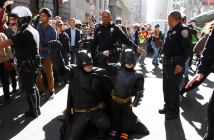
Editor’s Notes: The Walk opened in IMAX 3D September 30th and will expand on October 9th in regular 2D and 3D. For an additional perspective on the film read The Walk: ‘An Immersive Experience’.
An extended, at times bravura, based-on-a-true-story riff on Ocean’s 11 (call it Petit’s 5), The Walk revisits – and in the process, fictionalizes, sensationalizes, and sanitizes – the subject covered by James Marsh’s justifiably lauded, Academy Award-winning 2008 documentary, Man on Wire, Philippe Petit’s improbable, death-defying wire walk between the Twin Towers (World Trade Center/WTC) in 1974 (Petit was all of 24). Directed by Robert Zemeckis (Flight, Castaway, Forest Gump, the Back to the Future trilogy) with his usual hyper-attention to the craft of filmmaking and technological advancement, The Walk offers an overabundance of visual and sensory pleasures, especially during the last 40 minutes, but it also suffers from thinly drawn, one-dimensional characters, a misconceived narrative device (Petit atop the Statue of Liberty in effusive, exuberant expository mode), and an often grating faux-whimsical, idiosyncratic tone highlighted by Joseph Gordon-Levitt’s over-caffeinated performance and faux-French accent.
The Walk offers an overabundance of visual and sensory pleasures, especially during the last 40 minutes. . .
Based on Petit’s 2002 memoir, “To Reach the Clouds,” The Walk doesn’t so much unfold as it unwinds or unravels, using Petit’s poetic tendencies to skim his biography, beginning with his love for the high wire from an early age thanks to a traveling circus, continuing with his semi-successful attempts to make what passed for a living in late ‘60s France as a street performer (minus any mention or notation of the turbulent socio-political events of the time), his meet-cute romance with Annie Alix (Charlotte Le Bon), a busker, and the inevitable, fateful discovery of a magazine article about the construction of the World Trade Center while he waited in a dentist’s office, his training under Papa Rudy (Sir Ben Kingsley), an expert at all things high-wire related, to the idea, however irrational, however dangerous, to become the first and quite possibly the last man to walk on a wire between the Twin Towers. Petit’s extroverted personality, manic enthusiasm, and force of will create an cult-like atmosphere among his friends, supporters, and eventually co-conspirators with Petit at the center (or rather pedestal).
 Besides Annie, acknowledged as his first co-conspirator, Petit convinces Jean-Louis (Clément Sibony), a photographer, and Jean-Louis’ friend and acrophobe, Jean-Francois (César Domboy), to join him. After multiple recon missions to the United States and back, Petit eventually settles on August 7, 1974 to complete his high-wire act or “coup” as he calls it. Two more co-conspirators join him, Barry Greenhouse (Steve Valentine), Petit’s inside man at the WTC), and Jean-Pierre (James Badge Dale), rounding up Petit’s Ocean’s 11-style crew to five. Two more men, stoners, join Petit’s crew later on, but prove to be less than reliable (Zemeckis still doesn’t like counter-culture types). The Walk eventually segues from the familiar “Let’s Get the Band/Crew Together” plot to Petit’s heist-style coup, with the usual, unsurprising mix of missteps, reversals, and obstacles to overcome before Petit can finally step onto the high wire ingeniously suspended between the Twin Towers.
Besides Annie, acknowledged as his first co-conspirator, Petit convinces Jean-Louis (Clément Sibony), a photographer, and Jean-Louis’ friend and acrophobe, Jean-Francois (César Domboy), to join him. After multiple recon missions to the United States and back, Petit eventually settles on August 7, 1974 to complete his high-wire act or “coup” as he calls it. Two more co-conspirators join him, Barry Greenhouse (Steve Valentine), Petit’s inside man at the WTC), and Jean-Pierre (James Badge Dale), rounding up Petit’s Ocean’s 11-style crew to five. Two more men, stoners, join Petit’s crew later on, but prove to be less than reliable (Zemeckis still doesn’t like counter-culture types). The Walk eventually segues from the familiar “Let’s Get the Band/Crew Together” plot to Petit’s heist-style coup, with the usual, unsurprising mix of missteps, reversals, and obstacles to overcome before Petit can finally step onto the high wire ingeniously suspended between the Twin Towers.
Anyone looking, however, for the “why” behind Petit’s feat will be hard pressed to find one in The Walk.
A twinge of melancholic grief accompanies every shot of the Twin Towers, an emotion paradoxically heightened by the unreal, CG-sheen given to the towers by Zemeckis’ animators. It’s there, finally, that The Walk segues into something else altogether, something altogether better, a visceral, immersive amusement park experience brought to moviegoers by the best visual effects a Hollywood studio can buy. Zemeckis deploys a free-flowing visual style punctuated by an independent, free-floating camera that not only follows Petit as he performs what some considered a dangerous stunt (Petit considered it transcendent performance art), but circles and swoops around him, tracing figure eights in multiple, vertiginous dimensions. Those last forty minutes practically justify the price of admission, diminishing or even obviating Zemeckis’ and co-screenwriter Christopher Browne’s misconceived narrative and tonal choices.
Anyone looking, however, for the “why” behind Petit’s feat will be hard pressed to find one in The Walk. On one level, Zemeckis and Browne deserve credit for avoiding the usual reductive pitfalls of bio-dramas (i.e., a central, personality-altering experience), but they also consciously avoid any attempts at psychological depth or nuance. Zemeckis may be giving his intended audience what he thinks they want (i.e., spectacle over substance), but that doesn’t excuse The Walk’s general inattention to character development. The Petit we meet in the first scene and the Petit we see and hear in the last one doesn’t change (despite supposedly aging the better part of a decade). Zemeckis’ also strips Petit of his narcissism, egotism, and megalomania that Marsh’s documentary deliberately showed. Marsh didn’t hesitate to depict Petit as a flawed, if remarkable, human being, an artist (if primarily in his own mind) compulsively, obsessively pursuing a seemingly impossible dream.
Though short on the "why" behind Philippe Petit's famous 1974 high-wire walk between the Twin Towers, The Walk, in its third act, becomes a visceral, immersive, and even emotional experience.



